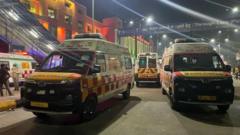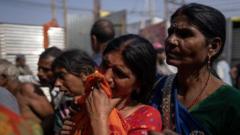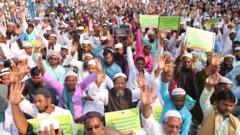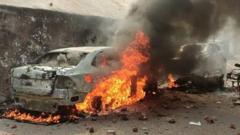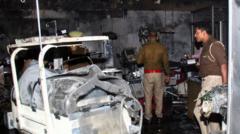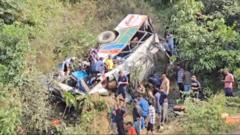A chaotic scene unfolded in New Delhi as 15 Hindu pilgrims were killed in a stampede while attempting to board trains for the Kumbh Mela festival, drawing attention to crowd management challenges at the world’s largest religious gathering.
Tragedy Strikes Kumbh Mela: 15 Pilgrims Dead in New Delhi Train Station Stampede

Tragedy Strikes Kumbh Mela: 15 Pilgrims Dead in New Delhi Train Station Stampede
A devastating stampede at New Delhi's railway station claims 15 lives as thousands flock to religious festival.
As throngs of pilgrims surged at New Delhi Railway Station, attempts to board the delayed trains bound for the Kumbh Mela spiraled into tragedy. Reports state that 15 individuals lost their lives, with an equal number sustaining injuries. Atishi, the caretaker chief minister of the Delhi region, confirmed this grim toll outside a local hospital on that fateful Saturday.
Prime Minister Narendra Modi expressed his deepest condolences via social media, assuring that authorities were taking necessary steps to support the affected families. Meanwhile, Ashwini Vaishnaw, the country's railroad minister, promptly announced an investigation to determine the circumstances surrounding the incident.
The surge in crowds was reportedly exacerbated by delays in the trains traveling to the Kumbh Mela, which is anticipated to attract over 400 million devotees in celebrates of this monumental religious event. To cope with the burgeoning passenger numbers, the Indian Ministry of Railways later dispatched additional trains, aiming to alleviate the overwhelming pressure at the station.
This year's Kumbh Mela, held in Prayagraj, Uttar Pradesh—where the Ganges and Yamuna rivers conjoin—is further magnified by a celestial event occurring once every 144 years, making this gathering particularly significant. Consequently, managing the massive influx of pilgrims remains a key challenge for Indian authorities.
Historical context reveals that crowd control has been an ongoing issue, with previous stampedes leading to fatalities. Notably, 30 pilgrims were killed just last month, and incidents in earlier festivals have claimed dozens of lives in the past. The arduous nature of crowd management during religious events, especially those of this scale, poses a serious concern for public safety and logistical coordination.
The Kumbh Mela, also known as Maha Kumbh this year, signifies a deeply spiritual pilgrimage for Hindu devotees, who believe in the ritual cleansing of sins by bathing in the sacred confluence of the three rivers at Prayagraj. As the spiritual gatherings continue, officials are urged to prioritize safety protocols and crowd control measures to prevent further tragedies.
Prime Minister Narendra Modi expressed his deepest condolences via social media, assuring that authorities were taking necessary steps to support the affected families. Meanwhile, Ashwini Vaishnaw, the country's railroad minister, promptly announced an investigation to determine the circumstances surrounding the incident.
The surge in crowds was reportedly exacerbated by delays in the trains traveling to the Kumbh Mela, which is anticipated to attract over 400 million devotees in celebrates of this monumental religious event. To cope with the burgeoning passenger numbers, the Indian Ministry of Railways later dispatched additional trains, aiming to alleviate the overwhelming pressure at the station.
This year's Kumbh Mela, held in Prayagraj, Uttar Pradesh—where the Ganges and Yamuna rivers conjoin—is further magnified by a celestial event occurring once every 144 years, making this gathering particularly significant. Consequently, managing the massive influx of pilgrims remains a key challenge for Indian authorities.
Historical context reveals that crowd control has been an ongoing issue, with previous stampedes leading to fatalities. Notably, 30 pilgrims were killed just last month, and incidents in earlier festivals have claimed dozens of lives in the past. The arduous nature of crowd management during religious events, especially those of this scale, poses a serious concern for public safety and logistical coordination.
The Kumbh Mela, also known as Maha Kumbh this year, signifies a deeply spiritual pilgrimage for Hindu devotees, who believe in the ritual cleansing of sins by bathing in the sacred confluence of the three rivers at Prayagraj. As the spiritual gatherings continue, officials are urged to prioritize safety protocols and crowd control measures to prevent further tragedies.



